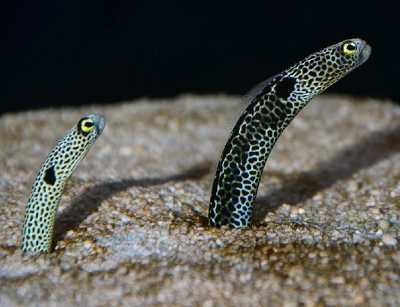 SKC Films Library SKC Films Library |
| SKC Films Library >> Science >> Zoology >> Fishes >> Class Actinopterygii |
| Spotted Garden Eel Heteroconger hassi
Description This unusual fish is up to 16 inches long but only about 1/2 inch in diameter. As its name suggests, its body is covered with tiny odd-shaped spots. There are also three prominent black patches -- one surrounding the gill opening and pectoral fin, the second half way along the body, and the third surrounding the anus. Juveniles are entirely black. Males are much bigger than females. The male's jaw also sticks out further than the female's. Distribution and Habitat The spotted garden eel inhabits warm parts of the Pacific Ocean and the Red Sea from East Africa, north to Japan, south to New Caledonia and east to the Pitcairn Islands, and including the Great Barrier Reef of Australia. They live on the sandy sea floor bordering coral reefs at depths of 23 to 150 feet, and will also be found in areas densely populated with seagrass. Garden eels spend almost their entire life in a self-dug burrow. To excavate that burrow the eel makes itself very rigid by tightening all of its muscles and driving its tail into the sandy ocean floor. It uses the slime on its body to create a cement-like substance, stopping the burrow from caving in. Garden eels live in colonies consisting of hundreds (sometimes thousands) of individuals. The largest males live in the center of the colony, positioning themselves in the best areas to make a home and get food. When they're not hiding, these fish sway in the current like blades of seagrass, hence the "garden" part of their common name. Diet To feed, the garden eel extends most of its body out of its burrow and faces the current. It then sways back and forth, picking tiny animals and eggs from the water that flows by. A single garden eel can eat up to 600 tiny animals in one meal. Reproduction Heading into mating season, males and females move their burrows closer together. Once a male picks a female to mate with, he defends her, keeping other males away. The male strikes at and even bites the head of any brave competitors. After mating, garden eels release the fertilized eggs into the current. After hatching, the larvae float along until they reach a certain size. After they are large enough, the young garden eels swim down and make a burrow of their own. Predators Snake eels dive deep into the sand, far from a colony of gardens eels. The snake eels then slither their way underneath the garden eels' burrows, attacking them from underneath. Large triggerfish dive bomb garden eel colonies, digging them out of the sand when the eels try to hide inside. Scientific Classification phylum Chordata |
| SKC Films Library
>> Science
>> Zoology >> Fishes >> Class Actinopterygii This page was last updated on June 22, 2017. |
